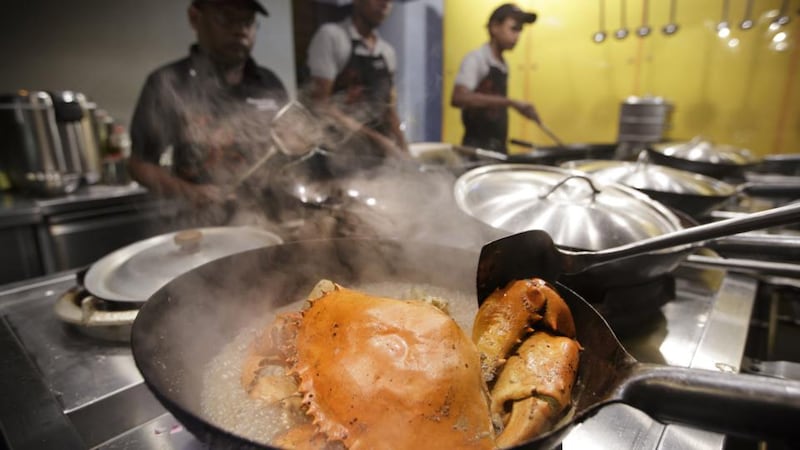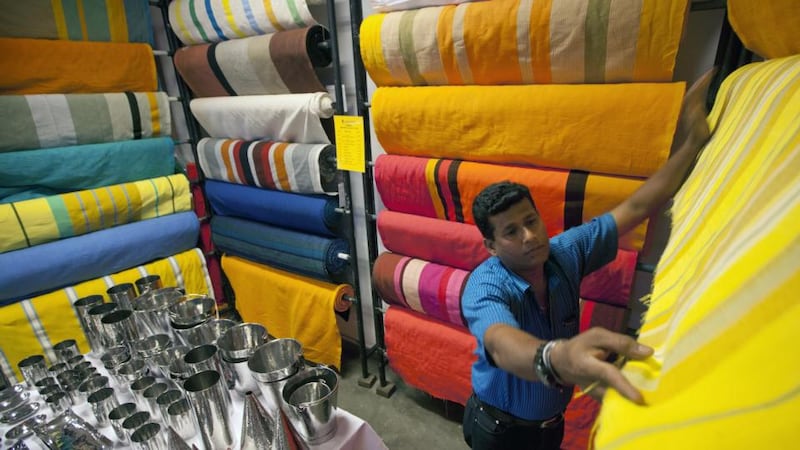Sri Lanka is so jam-packed with alluring outdoorsy activities that visitors often high-tail it out of the capital a day or two after arriving, choosing instead to spend their vacation days lounging on a southern beach, whale-watching off the coast or leopard-spotting in a national park. Yet Colombo is fast becoming a draw in itself.
This city of 555,000 people has been on fast-forward since a 25-year civil war ended in 2009. Checkpoints have come down, trendy lounge bars have opened up, and the vibe is one of cautious optimism combined with an increasingly cosmopolitan outlook. Today, this colourful city on the Indian Ocean, with its laid-back island ambience, palm trees, decaying colonial buildings and smattering of modern office blocks, is the perfect place to get a sense of where Sri Lanka is going after so many tumultuous years.
Friday
1pm
1 Rice and curry
Hungry like the wolf? Stop at the capacious Pagoda Tea Room, arguably the oldest dining establishment in the city (circa 1884) and the place where the Grammy-winning Duran Duran video was filmed. Find a seat in the cool and cavernous dining room and order what almost every Sri Lankan eats for lunch: "Rice and curry." Not strictly curry in the Western sense, this is a heaping pile of rice topped by three or four of the day's offerings of delicately spiced coconut, chile and vegetable concoctions; vegetarian version, 170 rupees (94 cents); beef version, 250 rupees (€1.38).


2:30pm
2 To market
Experience the merging of Sinhalese, Tamil and Muslim cultures in the tightly packed streets of Pettah, Colombo's main market. Shirtless men in sarongs haul carts loaded with vegetables, electrical goods spill out of shop doorways, and mosques compete with Hindu temples for space. Ayurvedic medicine for what ails you (widely used in Sri Lanka) can be found in abundance on Fifth Cross Street, and jewellery shops, many selling the cut-price gems (sapphires in particular) for which the country is noted, line Sea Street.
5pm
3 3 Sunset Stroll
Cool off from the immense heat of the day with a stroll along Galle Face Green. This broad stretch of lawn borders the ocean on one side and the city's business district on the other. On evenings and weekends, the green fills up with a cross-section of Colombo citizens, from elderly couples enjoying the sea breeze to groups of scruffy youths playing cricket, and still others strolling, flirting, jogging and flying kites.
Pick up a couple of isso wade (deep-fried shrimp cakes, around 50 rupees each) from one of the myriad vendors. Then, just before sundown, settle in for a refreshing gin and tonic (770 rupees) on the veranda of the venerable Galle Face Hotel, at one end of the green.
The hotel was built by the British in 1864, and its Victorian suites have played host to a varied collection of guests, including Richard Nixon, Indira Gandhi, Yuri Gagarin and Arthur C. Clarke, who wrote the final chapters of “3001: The Final Odyssey” here. The veranda offers some of the city’s best views of Sri Lanka’s gorgeous sunsets: a spectacular daily show of fiery pink, orange and red sky as the sun sinks into the ocean.
8pm
4 Crabs and cocktails
The Ministry of Crab combines two grand Sri Lankan traditions: cricket and crab. A joint project between two famous local cricketers and a top restaurateur, Dharshan Munidasa, this elegant restaurant serves up top-notch fresh crabs in garlic, chile, butter and pepper variations (dinner for two, around 10,000 rupees). The Ministry is in the much-lauded Old Dutch Hospital, a 17th-century building of thick walls and red-tiled roofs, converted after the war into a beautiful structure that houses the city's trendiest cafes and restaurants, set around courtyards. For postdinner cocktails, go to Colombo Fort Café or Heladiv Tea Club (around 600 rupees).
Saturday
9am
5 String hoppers
Start the day the local way with "string hoppers," discs of rice flour noodles commonly eaten (by hand) for breakfast. Servers at the bare-bones but popular Amirthaa bring a plate to the table, then ladle on yellow dal and pol sambal (a sort of Sri Lankan salsa, based on grated coconut) from metal buckets.
Add a steaming glass of chai and you have a satisfying breakfast for less than 200 rupees.
10am
6 Tropical Modernism
Stroll around algae-laden Beira Lake in the city centre, once used to transport goods within the city and now patronized by couples in swan-shaped paddleboats. Then visit the Seema Malaka temple, a meditation centre designed by Geoffrey Bawa, Sri Lanka's best-known architect, known for his signature tropical modernism style. The temple (100 rupees) extends from the bank into the lake, an elegant construction of wood and stone with a surfeit of Buddha statues. It's a peaceful haven in a city filled with honking tuk-tuks and buses blasting Indian pop tunes.
An abundance of pelicans and storks call the lake home, and it's not uncommon to see a yard-long monitor lizard pulling itself onto the banks.
Noon
7 Lunch with the Burghers
Dutch Burghers (the descendants of Dutch colonists in Sri Lanka, most of mixed race) once played a prominent local role, and while their numbers are much diminished, the Dutch Burgher Union remains their century-old club, brimming with Old World nostalgia. Its casual ground-floor cafe serves the best lamprais (490 rupees) in the city. Lamprais is a Dutch-influenced Sri Lankan original, a banana-leaf package of rice, meat curry, eggplant, frikkadel (a kind of meatball) and shrimp paste. Order in advance; ask your hotel to call.
2pm
8 Coffee break
Ceylon tea may be famous, but in the 1860s Sri Lanka (Ceylon, until it changed its name in 1972) was the world's biggest coffee producer. It was only after blight struck that the British converted their acreage to tea. Good coffee is still hard to find, but for a pick-me-up, head to Hansa Coffee. This relaxed bohemian cafe with colourful cushions and wall hangings seats about 10 people, which facilitates conversation with other customers and the friendly baristas. Its Seattle-born owner Laurence Goldberg has been working to revive Sri Lanka's coffee culture since 1996. The excellent beans are shade-grown and roasted in the highlands, which means profits remain in the country. A 200g bag is about 550 rupees.
5:30pm
9 Train time
Colombo's antiquated yet meltingly romantic trains (with bare-bones interiors and often with surplus passengers clinging to the side) run straight down the coast. Buy a ticket (10 rupees) from any of the colonial-era train stations; then hop aboard. Stand in the open doorway and watch the waves of the warm sea break just feet away. Arrive 15 minutes later in Mount Lavinia, a relaxed southern neighbourhood that's home to the city's best beach — a clean, wide stretch of yellow sand. Stop in any of the numerous seaside restaurants for a cold Lion beer (200 to 400 rupees) and watch the families and couples frolic in the waves as the sun goes down — some fully clothed for modesty, but having the time of their lives.
8pm
10 Dinner in style
Head back into the city centre in a tuk-tuk (around 400 rupees) and coast up Galle Road, past temples, mosques, churches, shopping malls, hole-in-the-wall "pure veg" restaurants, and vendors of Bombay sweets while breathing in Colombo's unique aroma of exhaust, curry and ocean breeze. Disembark at the Gallery Café, the favourite haunt of Colombo's smart set. This stylish courtyard restaurant is housed in Geoffrey Bawa's former office, and serves up elegant fusion food like black pork curry (1,095 rupees), best accompanied by a tamarind chile martini (945 rupees). Finish up with the jaggery crème brûlée (695 rupees), which incorporates the local unrefined palm sugar (jaggery) into a French classic. Note the scrap metal sculptures by Prageeth Manohansa, one of Sri Lanka's most significant up-and-coming artists.
11pm
11 Colombo cool
Join Colombo's young nabobs at QBaa (entry, 1,000 rupees, deducted from your bar bill), home to the city's best live music. Rub elbows with the beautiful people — a mix of resident foreigners and local trendsetters educated overseas — who gather to schmooze, down sangria (980 rupees) and Champagne cocktails (880 rupees) and get in the groove to consistently excellent groups like Glory, a boy band that performs energetic cover versions of everything from Stevie Wonder to Jason Mraz.
Sunday
11am
12 Go barefoot
The ideal place to while away a leisurely Sunday, Barefoot is a Colombo landmark. This frangipani-scented compound is a combination art gallery, restaurant, cafe and shop, and is the best place to pick up colourful hand-loomed textiles, books on Sri Lanka, handmade stuffed toys and other gifts.
The garden restaurant, studded with palm trees, has live jazz on Sundays and lunch items like spinach quiche (900 rupees) or deviled prawns, a spicy concoction of shrimp sautéed with chile, garlic and ginger, with rice (1,050 rupees).
– The New York Times syndication
















